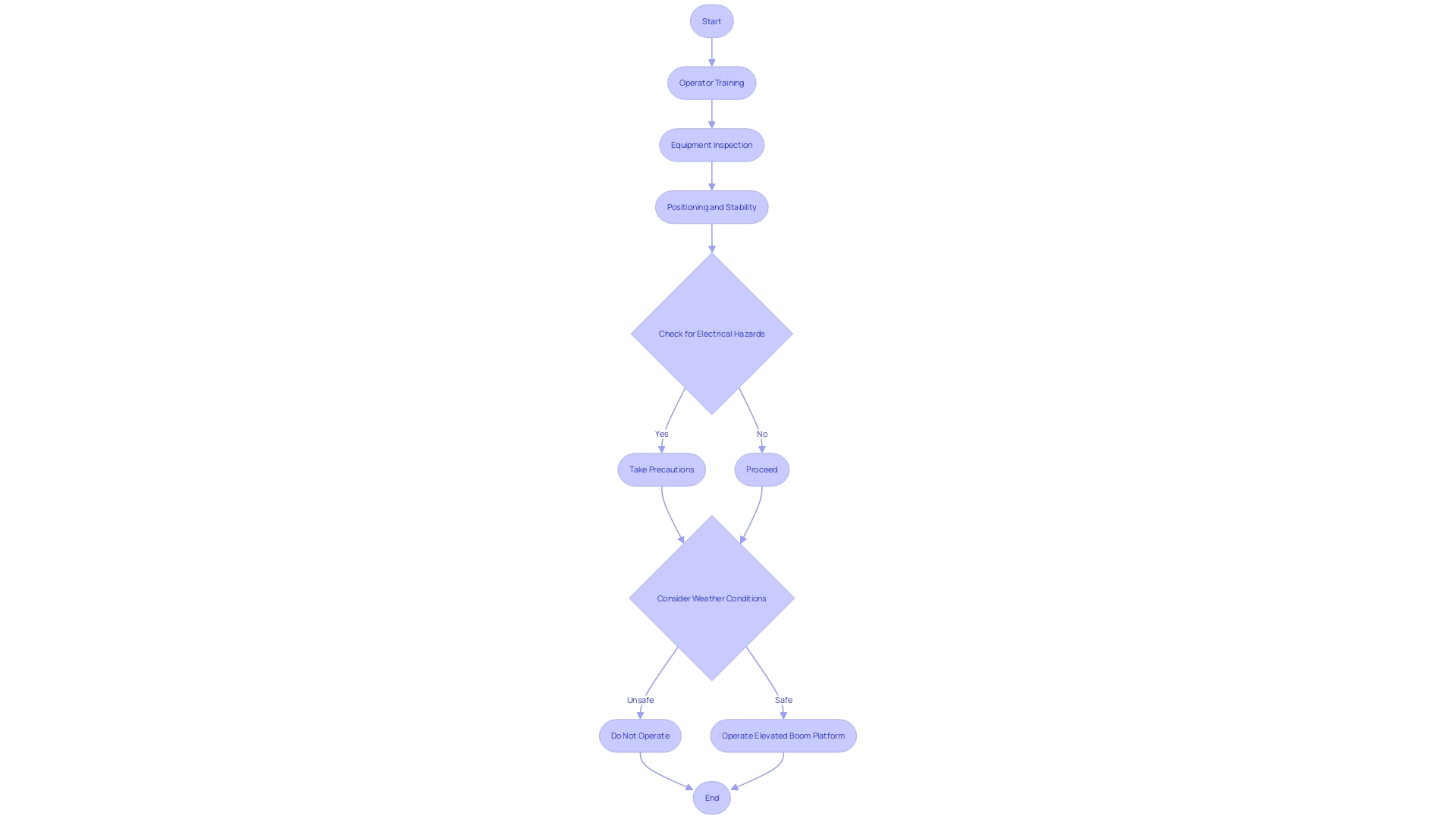Introduction
Aerial boom lifts are essential tools in the construction industry, enabling workers to navigate heights and challenging environments with ease. From scissor lifts to boom lifts and articulating lifts to telescopic lifts, each type serves a specific purpose in addressing the demands of different job sites. By understanding the array of aerial lifts available, construction projects can be completed safely, efficiently, and without costly delays.
Furthermore, aerial lifts find applications in various industries, including manufacturing, facilities management, tree care, landscaping, and film production, providing vital assistance in reaching new heights. Safety precautions are of utmost importance when operating aerial lifts, with operator training, equipment inspection, and fall protection being key considerations. Adhering to strict safety protocols ensures accident prevention and mirrors the commitment to safety seen in the commercial aviation industry.
Proper use and operation guidelines, along with regular maintenance, contribute to workplace safety and project success. As the industry continues to evolve, the importance of safety and proper handling of aerial lift equipment remains paramount.
Types of Aerial Lifts
Aerial boom elevators are essential tools in the domain of construction, where the capacity to traverse heights and challenging environments is crucial. These machines come in different shapes and sizes, each tailored for specific tasks and work conditions.
-
Scissor Lifts are renowned for their vertical ascent capabilities, making them perfect for indoor maintenance or tasks where stability is required. Their platform moves strictly up and down, creating a reliable base for operations.
-
Boom Lifts or cherry pickers, are recognized for their flexible arm that extends both vertically and horizontally, enabling workers to reach heights and spots that would otherwise be inaccessible. This makes them essential for projects that demand access to elevated or awkward positions.
-
Articulating platforms, also referred to as knuckle platforms, feature a segmented arm capable of bending, enabling them to maneuver around obstacles. This adaptability is crucial when access is restricted, or precision placement of materials is necessary.
-
Telescopic Lifts have an unyielding telescopic arm that can achieve remarkable heights, commonly utilized in construction and maintenance for tall structures. Their design is instrumental for projects that stretch towards the sky.
Every category of elevated platform makes a distinct contribution to the effective finalization of construction projects by meeting the diverse requirements of various work locations. For example, telescopic handlers have revolutionized job site efficiency by performing multiple functions that once required several pieces of equipment and manpower. This versatility not only saves on the costs associated with renting or purchasing additional machinery, but it also trims down the time needed for completion, significantly boosting productivity.
The progress in airborne elevation technology is mirrored by the expansion in the drone market, which further showcases the industry's development in airborne operations. Drones are increasingly adopted for tasks that are too risky or complex for humans, such as surveying and inspection of infrastructure. Their burgeoning popularity is fueled by their speed, cost-efficiency, and the enhanced safety they provide.
Comprehending the range of elevated platforms accessible is crucial for choosing the appropriate machinery for the job at hand. The right choice can mean the difference between a project that is safely and efficiently executed and one that faces costly delays and challenges.
Applications of Aerial Lifts
Aerial elevators are the unacknowledged champions in a multitude of industries, offering crucial support in reaching new heights. In construction, the multitude of tasks like installing electrical and HVAC systems or repairing building exteriors is made more efficient through the use of elevated platforms. They ensure safety and efficiency for workers operating at height, much like the team that worked on the Higher Roch Tower in France, using advanced software to bring their architectural vision to life. Maintenance and inspection duties, especially in industries such as manufacturing and facilities management, also depend on elevated platforms for accessing difficult-to-reach machinery and infrastructure, ensuring the smooth running of regular operations.
Tree care professionals and landscapers find elevated platforms essential for pruning and maintaining greenery or landscape features. These machines enable them to work safely, much like the equipment that supported the construction of iconic structures like the Sydney Harbor Bridge. For the film and media production industry, elevated platforms are essential, providing the stable platforms required for capturing stunning footage from above, an aspect that is increasingly important in an age where visual quality is paramount.
Furthermore, elevated platforms demonstrate their value in warehouse operations, where effectiveness and security are paramount. Managing inventory and stocking shelves become less of a challenge with elevated platforms, similar to how advanced air mobility companies strive to integrate efficient and safe transportation solutions into everyday life. The flexibility and dependability of elevated platforms make them essential across different occupations and undertakings, echoing the notion that without such machinery, achieving intricate construction endeavors would be considerably more difficult.
Safety Precautions and Hazards
Ensuring the well-being when operating elevated boom platforms is a paramount concern. Adherence to strict security measures can prevent mishaps similar to the aviation tragedies we've witnessed, such as the accident involving the flight from Philadelphia to New Jersey, where a lack of reevaluation of weather conditions and an inconsistent flight plan led to a fatal crash, emphasizing the significance of rigorous protocols.
To ensure the safe operation of aerial boom lifts:
- Operator Training: Operators must be thoroughly trained and authorized, understanding the equipment's features, controls, and safe operating procedures, akin to the meticulous training required for pilots to prevent accidents.
- Equipment Inspection: A thorough equipment inspection is essential before each use to identify any potential damage or malfunction, including checks on the platform, controls, protective devices, and hydraulic systems, as detailed inspections are a norm in aviation to ensure aircraft security. Utilize proper fall protection equipment, like a full-body harness, and fasten it to the designated anchor points on the elevated platform, reflecting the precautions taken in aviation.
- Positioning and Stability: Position the aerial equipment on stable and level ground, employing outriggers or stabilizers as per the manufacturerâs guidance to prevent accidents similar to the Seattle-Tacoma International Airport incident, where improper placement led to traffic disruptions. Compliance with the lift's maximum load capacity is essential, given the weight of operators, tools, and materials, which is comparable to the weight considerations vital to aircraft security.
- Electrical Hazards: Maintain a safe distance from power lines or electrical equipment and adhere to all electrical guidelines, as electrical hazards present significant risks, not unlike those in aviation.
- Weather Conditions: Avoid using elevated platforms in unfavorable weather conditions, such as strong winds or storms, to preserve stability and well-being, similar to how pilots must assess weather conditions prior to flights.
While the commercial aviation industry marks a year without any fatalities as a result of adhering to protocols for the sake of safety, it is crucial to maintain records of safety and avoid accidents by exercising the same level of caution when operating large machinery such as boom lifts. The objective is to reflect the aviation industry's dedication to security, as demonstrated by the continuous improvement in security indicators and significant investments in security education and infrastructure.

Proper Use and Operation Guidelines
Operating elevated platforms demands a mix of technical understanding, consciousness, and strict compliance with protocols for protection. Commencing with the thorough examination of the equipment's manual, operators need to completely understand the controls, security characteristics, and specific maintenance requirements of the elevated hoist. A careful pre-operation check is crucial, involving a thorough examination of controls, devices, and emergency mechanisms. Clearing and securing the work area ensures that the aerial lift has sufficient space for use and reduces the risk of accidents.
Safety measures are non-negotiable; operators must use guardrails, harnesses, and other provided safety devices consistently. Awareness of surroundings is pivotal, especially regarding overhead hazards such as power lines, and maintaining a safe operational distance is necessary to prevent incidents. For team operations, clear communication and coordination protocols, possibly involving hand signals or radios, are essential for a seamless workflow.
Regular maintenance, as specified by the manufacturer, is essential for the durability and secure operation of elevated platforms. Following these guidelines not only improves operational efficiency but also greatly contributes to workplace security and project success.
Historical precedents, like the construction of the Sydney Harbour Bridge or the Eureka Skydeck, showcase the indispensable role of lifting equipment in accomplishing monumental projects. Likewise, contemporary applications, like drones utilized by companies such as Aerialoop, showcase the continuous development of technologies for lifting in the air and their operational efficiencies. The significance of the security and appropriate handling of such equipment is reflected in industrial activities, as underscored by specialists who stress the connection between equipment management and workplace well-being.
Recent statistics from the commercial aviation sector, which mirrors aerial lift operations in terms of prioritizing security, reflect an impressive track record with a decrease in total accidents from the previous year. These figures underscore the effectiveness of rigorous safety practices and the continuous need for vigilance in all areas of operation involving heavy machinery and elevated work environments.

Conclusion
Aerial boom lifts are essential in the construction industry, enabling workers to navigate heights and challenging environments. Understanding the different types of aerial lifts is crucial for safe and efficient project completion.
Aerial lifts have diverse applications across industries like manufacturing, facilities management, tree care, landscaping, and film production. They provide vital assistance in reaching new heights and performing various tasks.
Safety precautions are paramount when operating aerial lifts. Operator training, equipment inspection, fall protection, proper positioning and stability, load capacity adherence, awareness of electrical hazards, and consideration of weather conditions are key to accident prevention.
Proper use and operation guidelines are vital for aerial lift operators. Technical knowledge, adherence to safety protocols, clear communication, coordination, and regular maintenance contribute to workplace safety and operational efficiency.
In conclusion, understanding the different types of aerial lifts, their applications, and prioritizing safety and proper handling are essential for successful construction projects. Adhering to safety protocols, following guidelines, and maintaining equipment ensure workplace safety, project success, and contribute to the ongoing evolution of aerial lift technologies.




